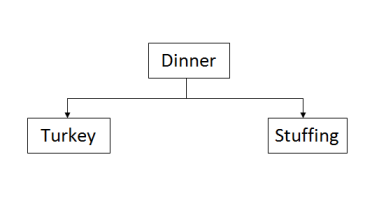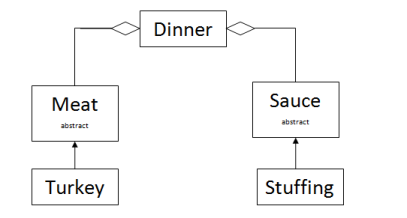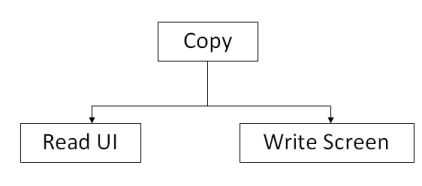CSC/ECE 517 Fall 2009/wiki3 5 SD
Dependency inversion principle
Introduction
The objects in our software should not get into a hierarchy where some objects are in the top-level ones, and dependent on low-level objects. Changes in low-level objects will then ripple-through to top-level objects which makes the software very fragile for change. It is always required that 'top-level' objects be very stable and not fragile for change, therefore the dependencies need to inverted.The point of dependency inversion is to make reusable software.Instead of two pieces of code relying on each other, they rely on some abstracted interface. Then either pieces can be reused without the other.
In conventional application architecture, lower-level components are designed to be consumed by higher-level components which enable increasingly complex systems to be built. In this composition, higher-level components depend directly upon lower-level components to achieve some task. This dependency upon lower-level components makes applications rigid, fragile and immobile. Goal of Dependency inversion principle is to decouple the high-level components from low-level components.
What is Dependency inversion principle?
Dependency inversion principle states that:
- High-level modules should not depend on low-level modules. Both should depend on abstractions.
- Abstractions should not depend upon details. Details should depend upon abstractions.
In conventional architecture, higher-level components depend upon lower-level components as depicted in the following diagram:1
http://4.bp.blogspot.com/_rO0OuTtGb2Y/SVgyGeeYzwI/AAAAAAAAATM/NPsuTSArKIg/s400/DIP1.png
In this diagram, component A depends upon component B, which in turn depends upon component C. Due to these dependencies, each of the higher-level components is coupled with the lower-level components.
The goal of the Dependency Inversion Principle is to decouple higher-level components from their dependency upon lower-level components. This may be achieved by creating interfaces as part of the higher-level component package which define the component’s external needs. This allows the component to be isolated from any particular implementation of the provided interface, thus increasing the component’s portability. The following diagram illustrates this relationship:1
http://4.bp.blogspot.com/_rO0OuTtGb2Y/SVgyGil3HQI/AAAAAAAAATU/lezX76UCH7Q/s400/DIP2.png
In this diagram, component A provides an interface which defines the services it needs. Component B satisfies this dependency by implementing the interface. The same relationship is additionally shown for components B and C. Take special note that the interfaces are packaged together with the higher-level components and are defined in terms of the higher-level component’s needs, not the lower-level component’s behavior. It is this association of the interface with the client component which logically inverts the conventional dependency flow.
Examples
Consider the following block diagram. Here the higher level class, Dinner depends upon the lower level classes Turkey and Stuffing.
Now, if we want to make Chicken instead of Turkey for dinner then the Dinner class becomes useless since it cannot be used in any other context other than making Turkey and Stuffing.
Notice that the module containing the high level policy, i.e. the Dinner() module, is dependent upon the low level detailed modules that it controls. (i.e. Turkey() and Stuffing()). If we could find a way to make the Dinner module independent of the details that it controls, then we could reuse it freely.
Consider the modified class diagram shown here:
Here we have a Dinner class which contains an abstract Meat class and an abstract Sauce class. Now we can have a loop within the Dinner class that gets ingredients from its abstract classes. Yet the Dinner class does not depend upon the “Turkey” nor the Stuffing class at all. Thus the dependencies have been inverted. Now we can reuse the “Dinner” class, independently of the “Turkey” and the “Stuffing” class.
Simmilarly below is another example:
Comparison
Dependency Inversion and Seperated Interface: Programmers think,just by using Interfaces ,Dependency inversion principle is implemented.It is not merely concerned with the use of interfaces, but the decoupling of high-level components from dependency packages.Simply stated, every case of programming to interfaces rather than implementations are not examples of the Dependency Inversion Principle.
The Separated Interface Pattern, defined in the book Patterns of Enterprise Application Architecture, sets forth an approach for decoupling components from the implementation details of their dependencies. This is accomplished by defining the interface of the dependency in a separate package from its implementation. One illustration given in the book for how this might be achieved places the interface within the client component package as depicted in the following diagram:1
http://1.bp.blogspot.com/_rO0OuTtGb2Y/SVgy82aHagI/AAAAAAAAAUA/SgUtcD26_pg/s400/DIP6.png
As one might observe, this diagram bear a striking resemblance to the structures advocated by the Dependency Inversion Principle. This similarity has led some to consider the two to be synonymous, and to a large extent they are. However, while the organization of the components set forth by each is nearly identical, slight nuances exists between the advocacy and description set forth by each approach.
First, while both have in view the decoupling of components from the implementation details of their dependencies, the Dependency Inversion Principle achieves this by assigning ownership of the interface to the higher-level component, whereas the Separated Interface pattern achieves this by separating the interface from the implementation … irrespective of any assumed package ownership. The distinction is the level of emphasis placed by the Dependency Inversion Principle on the value in reusing higher-level components over that of lower-level components. While such an approach is facilitated by the Separated Interface pattern, no such value assignments are assumed.Additionally, because the Dependency Inversion Principle assigns ownership of the interface to the higher-level component, it considers interfaces more closely aligned with their clients than with their implementations. The
Another nuance is the level of applicability advocated by each approach. The Dependency Inversion Principle declares that higher-level components should never depend upon lower-level components. In contrast, the Separated Interface pattern advocates a more conservative approach, even advising against introducing the complexity of separating interface from implementation prematurely, favoring rather to keep interface and implementation together until a specialized need arises.
Conclusion
Index
- Separated Interface Pattern :This pattern reduces coupling by placing the interface definition in a separate package as the implementation.
References
1.http://www.ctrl-shift-b.com/2008/12/examining-dependency-inversion.html
2.



